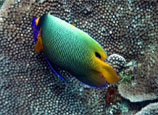
 |
| Poster of "Life of Pi" |
Many viewers like "Life of Pi", a movie directed by Chinese Hollywood director Ang Lee, but do not like "Back to 1942", another movie by Chinese director Feng Xiaogang, because faith saved cruel reality in the former while the cruel reality smashed all beliefs in the latter.
The two movies were shown almost at the same time and both of them told a story about hunger, disaster, survival, human nature and faith. However, they are very different in narrative style and value orientation.
In the movie "Life of Pi", Young Pi told two seemingly unrelated stories, which are actually one story. Survivals zebra, female orangutan, hyena, tiger, and Pi in the first story are the corresponding characters of the second story, which are vegetarian sailor, Pi's mother, chef, and Pi. The hyena killed the zebra and female orangutan, and then was killed by the tiger in the first story; and the chef killed the sailor and Pi's mother, and finally was killed by Pi in the second story. It is obvious that the animal-animal relationship is a metaphor for the real relations between characters in Pi's consciousness. The tiger is the embodiment of brutish nature of Pi, which was ignited by his mother's death. Since then, Pi had to learn to face everything alone and get along with his own brutish nature.
Obviously, it is by no means a fantastic story that occurred on the sea, but may expose a dog-eat-dog world. However, the second story did not touch the more cruel side, which was retained in the first story as a metaphor. The mysterious floating island where the story happened provides a lot of implications, including lotuses, ropes symbolizing farewell, acid lake, teeth, and the island looks like a woman lying on the sea. All seems to indicate that Pi ate his mother and other dead bodies, thereby awakening.















 Cumquat market in S China's Guangxi
Cumquat market in S China's Guangxi


![]()
